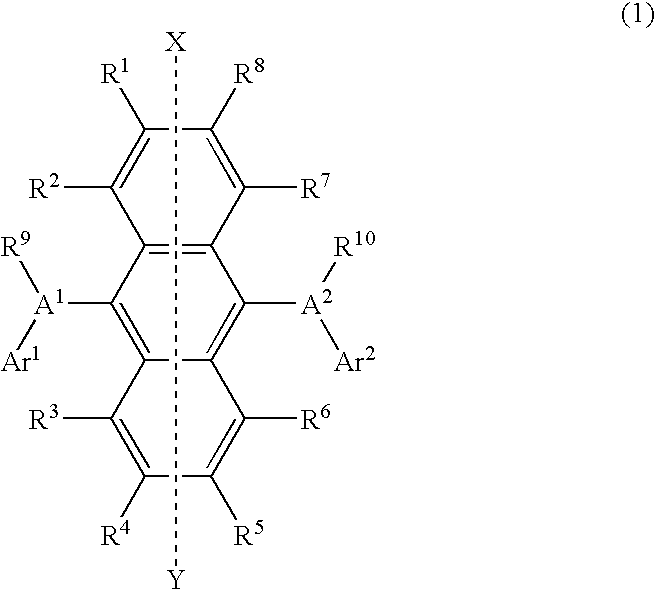Light-emitting material for organic electroluminescent device, organic electroluminescent device using same, and material for organic electroluminescent device
a technology of light-emitting materials and electroluminescent devices, which is applied in the direction of discharge tubes/lamp details, discharge tubes luminescnet screens, organic chemistry, etc., can solve the problems that have not yet been evaluated as light-emitting materials, and achieve the effects of great light-emitting efficiency, long life and great light-emitting efficiency
- Summary
- Abstract
- Description
- Claims
- Application Information
AI Technical Summary
Benefits of technology
Problems solved by technology
Method used
Image
Examples
synthesis example 1 (
Synthesis of 1-bromo-4-phenylnaphthalene)
[0112] 15 g of 1,4-dibromonaphthalene on the market, 7.7 g of phenylboronic acid and 1.8 g of tetrakis(triphenylphophine)palladium were mixed, followed by argon displacement. After adding 200 ml of toluene and 90 ml of 2M sodium carbonate aqueous solution thereto, it was refluxed on heating for 7 hours. After standing to cool, the organic layer was extracted by toluene, and then it was washed by water and saturated salt water. Subsequently the organic layer was dried by using sodium sulfate anhydride, and then the solvent was removed by distillation. The product was refined through a silica gel chromatography and then 8.9 g of 1-4-bromo-4-phenylnaphthalene of white crystal was obtained (Yield: 60%).
synthesis example 2 (
Synthesis of 1-bromo-4-(naphthelene-2-yl)naphthalene)
[0113] The procedure of Synthesis Example 1 was repeated except that 2-naphthalene boronic acid in place of phenylboronic acid was used, and then 7.5 g of 1-bromo-4-(naphthalene-2-yl)naphthalene of white crystal was obtained (yield: 43%). Synthesis Example 3 (Synthesis of 2-(biphenyl-2-yl)-6-bromonaphthelene) 15 g of 2,6-dibromonaphthalene on the market, 12.5 g of 2-biphenylboronic acid and 1.8 g of tetrakis(triphenylphophine)palladium were mixed, followed by argon displacement. After adding 250 ml of toluene and 90 ml of 2M sodium carbonate aqueous solution thereto, it was refluxed on heating for 7 hours. After standing to cool, the organic layer was extracted by toluene, and then it was washed by water and saturated salt water. Subsequently the organic layer was dried by using sodium sulfate anhydride, and then the solvent was removed by distillation. The product was refined through a silica gel chromatography and then 10.9 g of...
synthesis example 4 (
Synthesis of 9-(naphthalene-2-yl)anthracene)
[0114] 22.5 g of 9-bromoanthracene, 15.8 g of 2-naphthelene boronic acid and 2.0 g of tetrakis(triphenylphophine)palladium were mixed, followed by argon displacement. After adding 150 ml of toluene and 140 ml of 2M sodiumcarbonate aqueous solution thereto, it was refluxed on heating for 7 hours. After standing to cool, the crystal precipitated was filtrated it was washed by ethanol and toluene. The crystal obtained was recrystallized in toluene, followed by filtering and drying, and then 23.1 g of 9-(naphthalene-2-yl)anthracene was obtained (yield: 87%).
PUM
| Property | Measurement | Unit |
|---|---|---|
| temperature | aaaaa | aaaaa |
| temperature | aaaaa | aaaaa |
| temperature | aaaaa | aaaaa |
Abstract
Description
Claims
Application Information
 Login to View More
Login to View More - R&D
- Intellectual Property
- Life Sciences
- Materials
- Tech Scout
- Unparalleled Data Quality
- Higher Quality Content
- 60% Fewer Hallucinations
Browse by: Latest US Patents, China's latest patents, Technical Efficacy Thesaurus, Application Domain, Technology Topic, Popular Technical Reports.
© 2025 PatSnap. All rights reserved.Legal|Privacy policy|Modern Slavery Act Transparency Statement|Sitemap|About US| Contact US: help@patsnap.com



